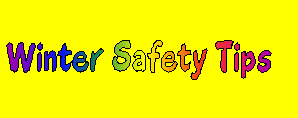 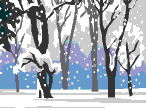
 When planning a winter holiday or ski
vacation, there are some special safety concerns that you need to
be aware of, especially when children are involved. We
hope that these suggestions will help make every winter holiday
a  . .
The tips contained in this section are tips only and you should
check with your health care provider, doctor, and/or pharmacist
before any vacation for more tips and health care
advice. CLICK
ON THE LIST TO VIEW TIPS OR SCROLL DOWN THE PAGE WINTER
SAFETY SUGGESTIONS

Here are some tips to keep in mind while your
family is enjoying the great outdoors during the winter season.
-
Check the weather report and heed precautions
and advisories. If weather warnings suggest a severe
wind chill or extremely low temperatures, consider avoiding
outdoor activities until the weather improves.
-
Drive Carefully - be prepared - see Winter Driving Tips.
-
Be aware of avalanche warnings also.
-
Be aware of symptoms and treatment for hypothermia,
snow blindness and frostbite.
-
See specific sections of this page for safety
tips on winter activities.
-
Practice Sun Safety.
-
Remember First Aid Tips
including a first aid supplies.
-
Dress in layers. It is very
important to keep warm and dry while enjoying outdoor
activities in the winter. See Winter Holidays - Ski Vacations
for tips on keeping warm and dry while enjoying winter
activities.
-
When not wearing a helmet, wear a hat, and a
neck guard. Keep ears covered too. Noses can
be covered with neck guard.
-
Click on the coat to
view travel news about the danger of drawstrings on children's
outerwear.
-
Make sure that clothes is comfortable.
Tight clothing restrict circulation and can increase changes
of frostbite.
-
Wear brightly coloured clothing - easier to be
seen.
-
Take extra care when dusk or evening
approaches as a result of reduced visibility.
-
Goggles that provide Sun
Safety can also protect eyes from cold, wind and snow.
-
Remove all drawstrings from children's snow
suits and avoid use of scarves to reduce the risk of
strangulation.
-
Don't overdo activities.
-
Try to maintain healthy eating and sleeping
habits.
-
Avoid alcohol, tobacco, drugs and consider
reducing caffeine consumption.
-
Take some time to relax and give children some
"down time" as well.
-
Have children (and adults) where helmets
designed for the activity if it involves a risk of head injury
or required by law - see helmets
-
Teach children never to touch metal during
cold temperatures.
-
Children should be taught never to throw snow
at other people. Snowballs can contain ice chunks or
stones that can cause harm including damage to eyes.
-
Never bury anyone in snow as there is a risk
of suffocation and teach children never to make tunnels in the
snow.
-
Don't let children eat snow. Even white
snow can contain pollutants from the air, including trace
minerals like mercury. Snow can also contain windblown
soils that can include animal fecal matter.
-
Teach children to never venture onto ice,
ponds or lakes without an adult first checking the ice.
-
Children should never play on snow piles near
parking lots or on the road side. Make sure children
never go near snow plows or areas being plowed.
-
See other Travel
Safety Tips for additional safety suggestions when
travelling.
Return to List


Avoid the risks of hypothermia by following the
Winter Safety Suggestions.
Hypothermia results from exposure to low
temperatures, wind and moisture over a period of time.
It can occur on the ski hill, in a car, falling in water that
is cold or anywhere else where these factors exist that cause
the body temperature to falls below normal. As a
parent you need to be aware of the causes and symptoms of
hypothermia in children as well as other adults and know what to
do when you suspect hypothermia. For older children
and teenagers, it is also important educate them. When conditions exist to pose a risk of
hypothermia be observant and seek medical attention immediately if
you suspect or observe any symptoms which can include:
-
Complaints about being cold and irritability.
-
Uncontrollable shivering
-
Impaired or slurred speech or vision
-
Clumsy movements
-
Blurred vision.
-
Severe symptoms can include stiff muscles, dark
and puffy skin, irregular heart and breathing rates and
unconsciousness.
If you notice any of the above symptoms, you
should get the person to a warm, dry place as soon as possible,
remove any wet clothing and seek medical attention
IMMEDIATELY. NEVER
RUB THE SKIN. Bundling in a blanket will help keep heat
in. An always soothing parent/child cuddle will help warm up
the child and also bring comfort to both.
Return to List


Avoid the risks of frostbite by following the
Winter Safety Suggestions.
Frostbite results from exposure to low
temperatures, wind and moisture over a period of time.
It can occur anywhere outside during cold temperatures. As a
parent you need to be aware of the causes and symptoms of
frostbite in children as well as other adults and know what to
do when you suspect frostbite. For older children
and teenagers, it is also important educate them. SEEK
MEDICAL ATTENTION IMMEDIATELY if you suspect Frostbite.
There are two degrees of frostbite:
-
Superficial frostbite that looks like
grey or yellowish patches on the skin, especially,
fingers, toes, face, ears but can occur on any exposed
skin. The first symptoms are usually numbness or
itching and prickly pain. The skin remains soft
but becomes red and flaky after it thaws.
-
Deep or Severe Frostbite looks like
waxy and pale skin and feels cold, hard and solid to
the touch. The areas turn blue or purple when
thawing and large blisters may appear when the area
warms up.
What to do if you suspect frostbite:
-
As soon as you suspect frostbite, get
out of the cold and to a warm place.
-
Seek medical attention immediately.
-
Warm affected area with warm body
part.
-
Remove any tight clothing to increase
circulation.
-
If affected area is partially thawed,
place in warm (not hot) water (102 to 106 degrees
Fahrenheit). If the water is too cool, thawing will
take too long. It takes about 20 to 40 minutes
for tissues to soften.
-
Have the victim drink warm fluids to
help increase circulation and warm the body - no
caffeine or alcohol.
-
NEVER rub or massage the affected area
and never put snow or ice on the frostbite. The
area can be protected with a fluffy clean bandage and
aloe vera cream can be applied.
Return to List


This is something that a lot of parents
are not aware of. Altitude Illness occurs when the
body does not adjust well to having less oxygen to breathe
at higher altitudes. Anyone can be affected by it,
not just children. To reduce the risk of this
affliction, consider ascending to high altitudes in
gradual steps to allow the body to adjust. If any
member of the family has a predisposed illness, check with
your doctor before you go on holiday. Medicines are
available to help prevent this illness and you should
consult your doctor.
Common symptoms of Altitude Illness are
headaches, dizziness, nausea, vomiting and
fatigue.
Other symptoms can include poor appetite,
vomiting, and trouble sleeping as well as pale, cool skin.
Watch for changes in behaviour in
children. Children can exhibit symptoms more quickly
and become much sicker than adults.
An unusual and uncommon form of Altitude
Illness causes fluid to collect in the lungs. If a
family member exhibits a cough that becomes wetter,
breathing becomes difficult and faster as well as a faster
heart beat, IMMEDIATELY SEEK MEDICAL ATTENTION.
If you suspect Altitude Illness, SEEK
MEDICAL ATTENTION AS SOON AS POSSIBLE. You
may need to descend to a lower altitude to relieve
symptoms or mild symptoms may be relieved by rest and
eating lightly.
Return to List


Helmets should be worn when participating
in any sport or activity that involves the risk of a head
injury and is mandatory in some sports, such as
snowmobiling. See Travel
News - Helmets for Skiers, Snowboarders and The National Ski Areas Association Launches 'Lids On Kids' Website To Promote Ski Helmets and Slope Safety Education.
Consider the following when deciding whether your child
should be wearing a helmet for any activity:
-
Many ski hills will not allow anyone
to enter a terrain park without a helmet, adults
included.
-
We are all aware of the need to wear a
helmet when riding a bike and some winter activities
present just as much, if not more, of a risk of head
injury.
-
Children are at the greatest risk of a
severe head injury from skiing or
snowboarding.
-
Children today are more accustomed to
wearing helmets for many activities, like biking,
in-line skating, hockey.
-
Studies have shown that helmets can
prevent or reduce the severity of head injuries during
skiing and snowboarding, as well as other winter
activities.
-
Wearing a helmet can save your life.
HELMET SAFETY TIPS:
-
Wear helmets that are specifically
designed for the activity you are participating in.
-
Helmets should be comfortable and well
fitting, with straps snug to prevent movement of the
helmet. When purchasing helmets, have them
fitted.
-
Helmets that have been involved in an
accident or fall, are cracked or old should be
replaced.
-
Recalls for helmets can also be
checked at www.cpsc.gov
to ensure that no recall notices for the helmets to be
used has been issued.
Return to List


The following information has been provided by
the National Ski Areas Association as a code of conduct for skiers
and snowboarders for the enjoyment and safety of all people
on the Hills. KNOW THE CODE AND PRACTICE IT.
YOUR RESPONSIBILITY CODE
1. Ski under control and in
such a manner that you can stop or avoid other
skiers or objects. Excessive speed is dangerous!
2. People ahead of you have the right
of way. It is your responsibility to avoid them.
3. You must not stop where you
obstruct a trail or are not visible from above.
4. When entering or merging onto a
trail or starting downhill, yield to others.
5. All skiers shall use devices to
prevent runaway skis.
6. Observe all posted signs and warnings. Keep off
closed trails and out of closed areas.
7. Prior to using any lift, you must have the
knowledge and ability to load, ride and unload
safely.
Return to List


HERE ARE SOME SAFETY TIPS FOR SKIING:
-
Always Practice Winter
Safety. See List
for other safety tips for skiers.
-
KNOW THE CODE
- Click to view and practice it.
-
Ensure that children wear a helmet -
Parents should too. See Helmet
Safety
-
Also see Winter Holidays - Ski Vacations
for skiing tips.
-
Consider taking lessons or having
children participate in lessons to learn the proper way
to ski and use the lifts. See Winter Holidays - Ski Vacations
for tips on Ski Schools and Teaching Little Ones how to
ski.
-
Maintain control.
-
Keep a trail map with you and know where
you are.
-
Warm up slowly and prepare yourself for
skiing, both mentally and physically. Begin each
run slowly until you are familiar with it.
-
If a ski slope is beyond your ability or
conditions become unsafe, take off your skis and side
step down the hill.
-
Stop skiing before you become too tired.
-
Be aware of the snow conditions and
avalanche warnings.
-
Make sure the equipment is well
maintained and appropriate for the age and ability of
the user.
-
Never Ski alone.
-
If you
are involved in or witness a collision or accident you
must remain at the scene and identify yourself to the
Ski Patrol.
-
When using Ski lifts, learn how to get
on and off safely. Never push to get on.
Consider asking the attendant to reduce the speed of the
lift if getting on and off with little children.
Always lower the bar on chair lifts.
-
Avoid scarves, loose clothing and tie up
long hair that can get caught in ski lifts.
-
See Travel News - Being Ready to Ski is no Accident.
-
HAVE FUN!!!
Return to List


HERE ARE SOME SAFETY TIPS FOR SNOWBOARDING:
-
Always Practice Winter
Safety. See List
for other safety tips for snowboarders.
-
Also see Winter Holidays - Ski Vacations
for snowboarding tips.
-
KNOW THE CODE
- Click to view and practice it.
-
Ensure that children wear a helmet -
Parents should too. See Helmet
Safety
-
Wrist guards can help prevent serious
wrist injuries from falls.
-
Consider taking lessons or having
children participate in lessons to learn the proper way
to snowboard and use the lifts. See Winter Holidays - Ski Vacations
for tips on Ski Schools and Teaching Little Ones how to
ski.
-
Maintain control.
-
Keep a trail map with you and know where
you are.
-
Warm up slowly and prepare yourself for
snowboarding, both mentally and physically. Begin
each run slowly until you are familiar with it.
-
If a slope is beyond your ability or
conditions become unsafe, take off your snowboard and
side step down the hill.
-
Stop snowboarding before you become too
tired.
-
Be aware of the snow conditions and
avalanche warnings.
-
Make sure the equipment is well
maintained and appropriate for the age and ability of
the user.
-
Never Snowboard alone.
-
If you
are involved in or witness a collision or accident you
must remain at the scene and identify yourself to the
Ski Patrol.
-
When using Ski lifts, learn how to get
on and off safely. Never push to get on.
Consider asking the attendant to reduce the speed of the
lift if getting on and off with little children.
Always lower the bar on chair lifts.
-
Avoid scarves, loose clothing and tie up
long hair that can get caught in ski lifts.
-
See Travel News - Being Ready to Ski is no Accident.
-
HAVE FUN!!!
Return to List


HERE ARE SOME SAFETY TIPS FOR SNOWMOBILING:
-
Always Practice Winter
Safety. See List
for other safety tips for snowmobilers.
-
Carry a first aid kit - see First Aid Tips
and an emergency survival kit.
-
Also see Winter Holidays - Ski Vacations
for snowmobiling tips.
-
Ensure that children wear a helmet -
Parents should too. Most places have laws with
respect to helmets on snowmobiles. See Helmet
Safety
-
Maintain control and never go too fast.
-
Leave an itinerary with someone so they
know where you are going and when you are expected back.
-
Keep a trail map with you and know where
you are. Stay on marked trails.
-
Be aware of the snow conditions and
avalanche warnings.
-
Make sure the equipment is well
maintained and appropriate for the age and ability of
the user.
-
Courses are available to learn safe
operating procedures for snowmobiles.
-
The American Academy of Pediatrics
("AAP") recommends that children under 16
years of age should not operate a snowmobiles as
adolescents and children may not have the strength and
skill to operate them safely. Children should
always be supervised by an Adult when using snowmobiles.
-
The AAP also recommends that children
under 6 are not strong enough to be transported safely
on snowmobiles. NEVER CARRY MORE THAN ONE
PASSENGER.
-
Snowmobilers can suffer hearing loss
from excess engine noise. Limit children's
exposure to this noise.
-
Ensure children do not touch hot
surfaces on machines and keep away from gasoline and
other chemicals.
-
Never take children on lakes
and rivers. Watch for hazards such as tree stumps,
fences, and crossing other trails. Proceed at a
safe speed and use caution on unfamiliar trails.
-
Consider pagers
and a cell phone (keep them inside your jacket so the battery is
kept warm).
-
Snowmobiles should not be used
to tow a tie, tub, sled or saucer. Only specifically
designed tow carts should be used.
-
Never Snowmobile alone.
-
Consider carrying a cell phone in case
of emergency. Keep it inside your coat so it
remains warm and the battery doesn't drain from the
cold.
-
Avoid scarves, loose clothing and tie up
long hair that can get caught on trees or in
equipment.
-
Ensure Children are well away when
loading and unloading machines.
-
HAVE FUN!!! See SNOWMOBILING FAMILY FUN
for some tips.
Return to List


-
Always Practice Winter
Safety. See List
for other safety tips.
-
Also see Winter Holidays - Ski Vacations
for tobogganing tips.
-
KNOW THE CODE
- Click to view and practice it.
-
Ensure that children wear a helmet -
Parents should too. See Helmet
Safety
-
Check the hill before you go down to
ensure it is safe and free from trees, rocks, fences or
other obstacles.
-
Never Toboggan on or onto a roadway or
parking lot.
-
Check that the toboggan or sled is in
good condition and there are no sharp edges or broken
parts.
-
Don't Toboggan at night or dusk as
visibility is reduced.
-
Maintain control and look for a clear
path before you go.
-
If a slope is beyond your ability or
conditions become unsafe don't go down the hill.
-
Never toboggan near or onto a lake,
river or other ice.
-
Toboggan on snow - avoid icy hills that
can cause excessive speed.
-
Teach children to sit forward, not
backwards, head first or lying down, to get out of the
way at the bottom of the hill and to roll off the
toboggan if heading for danger.
-
Avoid scarves, loose clothing and tie up
long hair that can get caught.
-
Teach children to slide down
the middle of the hill and climb up the sides.
-
Obey age limits for snow
racers.
-
Children under 5 should not go
down the hill alone - get a toboggan that is large enough for
an adult to go down with the child.
-
HAVE FUN!!!
Return to List


-
Always Practice Winter
Safety. See List
for other safety tips.
-
Also see Winter Holidays - Ski Vacations
for skating tips.
-
Ensure that children wear a safety
approved helmet -
Parents should too. Hockey Helmets with face cages
are best as they will protect the face in the case of a
forward fall also. See Helmet
Safety.
-
Make sure an adult checks
the ice before children venture onto any lakes, ponds or
rivers. Ice should be smooth and at least 10 cm
thick. NEVER SKATE NEAR OPEN WATER.
-
Never Skate Alone -
make sure children tell parents where they are going.
-
Skate in the same
direction as the crowd and avoid darting or racing.
-
If playing hockey, ensure
everyone has gloves on so hands won't get cut with
skates. Hockey helmets should be safety approved
with face masks worn by all children.
Return to List


Hot Tubs and Spas can be a great
way to relax and warm up after a day outside. It
also provides an opportunity to mingle with other
people. We offer some safety suggestions to keep
in mind so that your family's enjoyment of a hot tub is
done safely:
Keep safety in mind at all times. Also
see Pool and Beach Safety Tips
for additional tips.
NEVER LEAVE YOUR CHILDREN UNSUPERVISED-Children can drown in a
few inches of water in a few minutes - teach children to stay out of the
hot tub until an adult is supervising them. Watch that children do not touch any pool
chemicals.
Warn your children to stay
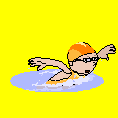 away from drains, filters and drain covers in
pools and hot tubs. Long hair should be tied up.
Drains can be very dangerous – see Travel News -
click the symbol:
away from drains, filters and drain covers in
pools and hot tubs. Long hair should be tied up.
Drains can be very dangerous – see Travel News -
click the symbol:
- NEVER PUSH ANYONE UNDER THE WATER.
- Check the hot tub area for safety including any
chemicals that may be around pool area.
- Children should never go on top of a hot tub cover.
- There should be no jumping, underwater swimming or diving in
the hot tub.
- Pregnant women and others with medical conditions should consult their doctors before entering
a hot tub or spa.
- Don't go into the Tub if you have open wounds or
sores. They can get infected by the bacteria in the
water or cause others to get infections.
- Everyone should hot tub with a buddy just in case there is a
problem.
- Be careful getting in and out of the hot tub as surfaces
surrounding it can become slippery. Hold young
children's hands when entering and exiting the tub.
- Soaking in a hot tub at high temperatures over a long period
of time can raise the body temperature to possible dangerous
levels. 10 to 15 minutes of soaking time should not be
exceeded. A temperature of 100 to 102 degrees Fahrenheit
should be comfortable. As children are more
sensitive to heat, they should not enter the hot tub unless
the temperature is reduced to not more than 95 degrees Fahrenheit
and stay in the tub not more than 10 minutes.
Check with your doctor if you have any concerns.
INFANTS
SHOULD NOT BE IN A HOT TUB.
- Children enter a hot tub slowly to be accustomed to the
temperature.
- Avoid alcohol and drugs while using a hot tub, but do
drink plenty of cool fluids to avoid dehydration while
enjoying the tub and help reduce body temperature.
- Make sure everyone but especially children do not touch
any electrical appliances or plugs. Don't let children
play with tub or jet settings.
- Enjoy the Hot Tub.
Return to List

All tips are offered as suggestions
only. While we have tried to provide you with a list
of suggestions to help parents when travelling with
children to keep them safe, unfortunately, we can’t
think of everything and it is the responsibility of
parents to ensure their children’s safety.
|
Safety News:
The National Ski Areas Association Launches 'Lids On Kids' Website To Promote Ski Helmets and Slope Safety Education
To View Winter Vacation
Tips Click Below:

For more safety information see:
For Winter Driving Tips Click Below:

For Safety Tips about Snow Blindness
Click Below:

First Aid Safety
Tips for Managing an Emergency from St. John Ambulance
See the following for more information on Winter Holidays:
To view Ski Resorts Click
Below:
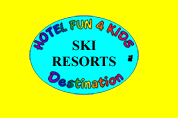
To view Travel News about
Ski Resorts Click Below:
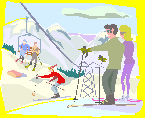
For Travel News
about Helmets for Skiers and Snowboarders, Click Below:

For Travel News about
Skiing Safety Click Below:
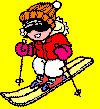
For Seasonal Holiday
Safety Tips Click Below:

See the following sections for specific tips:
For General Travel Safety Tips Click
on

For Car Safety Tips Click on

For Safety Tips when visiting Petting
Zoos and Animal Farms Click Below:

For Hotel Safety Tips Click on
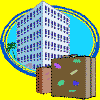
For Safety Tips for Using Public Washrooms Click on

For Playground Safety Tips Click on
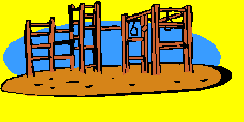
For Pool and Beach Safety Tips Click
on
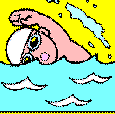
For Kids Club Safety Tips Click on

For Fire Safety Tips Click on

For Sun Safety Tips Click on
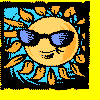
For First Aid
Tips Click on
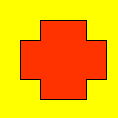
For In-line Skating Safety Tips Click on

For Safety Tips - Severe Allergic
Reactions Click on

For Tips on Buying Safe Toys Click
Below:
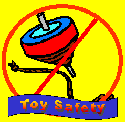
You may also want to check out
Travel
News - Safety Issues
Click below to return

|